The Effects of Fertilizer Runoff
Posted by Kenton Jones on Mar 21st 2024
Agriculture and farming is an important and necessary means of survival, pervasive in the environment we live in today. Without agriculture, there would likely be a scarcity of food throughout the world.
For thousands of years, many farmers relied on natural fertilizers like fish, manure, or ground bones. This natural agricultural process didn't harm the land. However, modern agricultural practices have introduced pollution processes into the mix, sometimes causing land, ecosystem, and environmental degradation — as well as agricultural runoff in drinking water.
Most of us think of fertilizer as a product that's great for yards, gardens, and croplands. But have you ever considered fertilizer's impact on the environment and our water supplies? This article discusses how fertilizer enters water, its effects on human health and our environment, and how to protect yourself and your family.
Contents In This Post:
What Is the Purpose of Fertilizer?
What Causes Fertilizer Runoff?
Types of Agriculture Pollution
The Effects of Fertilizer Runoff
How To Prevent Fertilizer Runoff
The Link Between Water Contamination and Your Body
How Homes Contribute to Nutrient Pollution
How To Protect You and Your Family
Contact Multipure for Fresh, Clean Drinking Water
What Is the Purpose of Fertilizer?
Fertilizers contain minerals such as nitrogen, phosphorus, and potassium — often in the form of nitrates and phosphates, which are nitrogen and phosphorus combined with oxygen. These nutrients provide plants with the food they need to grow and flourish.
Plants get most of their nutrients from the soil, but not all types of soil contain the nutrients plants need to thrive. Some soils contain only a few nutrients — a plant trying to grow there would be like a human trying to live on bread and water. Fertilizer contains a variety of nutrients to address these soil deficiencies.
But fertilizer doesn't always stay where we put it. When it runs off into other areas and adds nutrients to soil and water that don't need them, it can cause numerous issues, from environmental contamination to serious illness.
What Causes Fertilizer Runoff?
Agricultural application is one of the most common uses for fertilizer — farmers need it to ensure that their crops flourish. But sometimes, instead of remaining in the fields to nourish growing plants, fertilizer runs off and contaminates the groundwater and surrounding land.
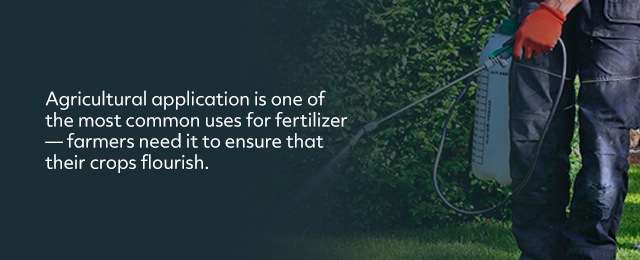
Common garden applications of fertilizer can lead to unwanted runoff as well. Misapplying fertilizer around your yard and garden can lead to waste and have adverse ecological effects.
Take the
instance with Ione Cleverley. She had a farmer-tenant who left her with unplanted fields. She then learned that every spring, as the soil moistened and warmed, it released nitrogen, which was both left over from the last synthetic fertilizer application and naturally occurring. The chemical washed into her stream by rain where it then flowed into the Skunk River and later the Mississippi.
Nitrogen converts to nitrate in water, where it presents two serious issues:
- Individuals who drink tap water contaminated by nitrate have increased health risks.
- Once nitrate gets to the ocean, it hyper-charges the growth of aquatic bacteria and algae that use up the water's oxygen and leaves it uninhabitable for numerous sea creatures.
This is just one example of the agricultural runoff effects on water.
What are some of the causes of this runoff?
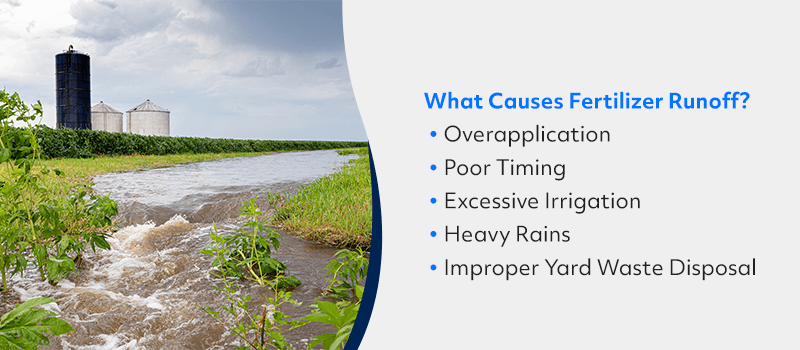
Overapplication
Using too much fertilizer almost inevitably leads to runoff. Once the plants' roots become saturated and can hold no more, the rest of the fertilizer will run off into less-saturated areas.
Poor Timing
When applied to frozen or partially thawed ground, fertilizers cannot penetrate the soil as easily as they would on a warmer day. Instead, it is likely to run over the hard ground until it reaches a more hospitable environment, like a stream, lake, or warmer soil. Additionally, if you fertilize while grass and other plants are dormant, their roots will be unable to absorb the fertilizer, and it will wash away in the rain much more easily. Many states have regulations that prohibit fertilizer application between November 15 and March 1.
Excessive Irrigation
Excessive irrigation or yard watering can also lead to fertilizer runoff. If agricultural land or garden soil becomes saturated with water, that water will run off to drier land that can absorb more moisture.
Heavy Rains
Even if you're careful with the amount of water you use on your plants, a heavy rainstorm can undo your meticulous work. Like excessive irrigation, heavy rainfall can sweep fertilizer away and contaminate the groundwater and soil with chemicals.
Improper Yard Waste Disposal
Clippings from your lawn often contain fertilizer residues. If you dump them carelessly — say into a nearby empty lot— those residues become vulnerable to runoff. The next heavy rain could carry them away and cause soil and water contamination elsewhere. If these clippings end up in drains, fertilizer chemicals can leach into the water supply.
How Is Water Used on a Farm?
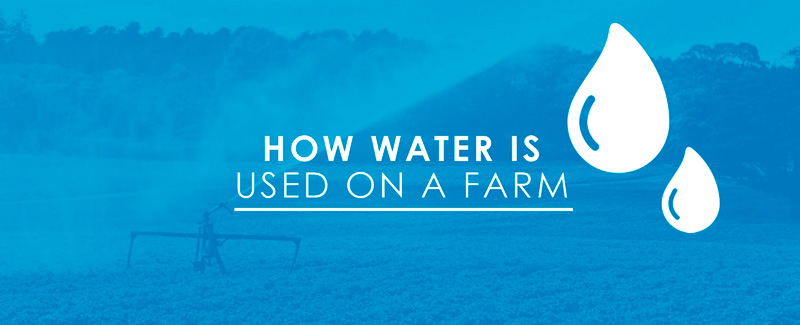
Unlike pollution from point sources, such as sewage and industrial treatment plants, nonpoint source (NPS) pollution comes from many sources. How does agriculture contribute to water pollution?
Snowmelt or rainfall moving through or over the ground can cause polluted runoff. As the water moves, it picks up human-made and natural pollutants and carries them away, where it then deposits them into watersheds through rivers, lakes, coastal waters, and underground drinking water sources.
Pollutants resulting from ranching and farming include:
- Pesticides
- Sediments
- Metals
- Pathogens
- Salts
Implementing management practices adapted to local conditions can reduce agricultural activities that have an impact on ground and surface water. Numerous methods created to decrease pollution also save farmers money and increase productivity.
Types of Agriculture Pollution
Several different types of agricultural pollution exist today, including:
1. Sedimentation
Water can become clouded with too much sediment, reducing the amount of sunlight aquatic plants receive. It can also smother fish larvae and clog the gills of fish.
2. Nutrients
Farmers apply nutrients like nitrogen, potassium, and phosphorus in the form of manure, chemical fertilizers, and sludge. They might enhance production by growing legumes and leaving crop residues. When these sources exceed the needs of the plants or are applied right before it rains, the nutrients may wash into aquatic ecosystems.
They then can cause algae blooms, which can take away boating and swimming opportunities, remove oxygen from water which kills fish, and create odor and a foul taste in drinking water. High nitrate concentrations in drinking water can lead to methemoglobinemia, a disease that can potentially cause death in infants — also referred to as blue baby syndrome.
3. Pesticides
Farmers use herbicides, fungicides, and insecticides to kill agricultural pests. These
chemicals may then enter the water, contaminating it through direct application, atmospheric deposition, and runoff. They can poison wildlife and fish, destroy animals' habitats they use for protective cover, and contaminate food sources.
4. Irrigation
Inefficient irrigation can lead to problems with water quality. For example, in arid areas, where the rainwater doesn't carry minerals deep into the soil, irrigation water evaporation can concentrate salts. Excessive irrigation may affect the quality of water by:
- Transporting pesticides, nutrients, and heavy metals
- Causing erosion
- Decreasing the amount of water naturally flowing in rivers and streams
Excessive irrigation can also cause selenium buildup. Selenium is a toxic metal that could harm waterfowl reproduction.
5. Animal Feeding Operations
Farmers confine animals in small lots or areas to efficiently maintain and feed livestock. The problem is, these confined lots become huge sources of animal waste. Approximately
1.3 million farms and ranches in the U.S. manage animal manure today.
Runoff from poorly-managed
facilities can carry pathogens like:
- Viruses
- Bacteria
- Oxygen-demanding organics and solids
- Nutrients
These can all contaminate fishing areas and create problems with water quality. Waste seepage can also contaminate groundwater. Farmers can use appropriate waste management systems to store and manage facility wastewater and limit discharges.
6. Livestock Grazing
Overgrazing by livestock can cause many problems including:
- Increasing erosion
- Exposing soils
- Encouraging undesirable plant invasion
- Destroying fish habitat
- Destroying floodplain vegetation and stream banks necessary for natural water filtration
Farmers can decrease the impact of grazing on water quality in several ways. They can keep livestock out of sensitive areas, adjust grazing intensity, promote revegetation, and provide alternative sources of shade and water.
The Effects of Fertilizer Runoff
Even though we generally think of nutrients as beneficial, the nutrients in fertilizer can cause harm when they come into contact with the natural environment. Here's what fertilizer does to water and adverse ecological impacts of runoff:
1. Eutrophication
One of the primary effects of fertilizer runoff is eutrophication — excessive nutrient richness in a body of water such as a lake, pond, spring, stream, or estuary. According to the National Oceanic and Atmospheric Administration (NOAA),
65% of studied estuaries and coastal waters in the contiguous United States have experienced eutrophication.
An abundance of nutrients may sound like a good thing, but eutrophication that results from fertilizer pollution in water upsets the delicate proportions of nutrients and disrupts the balance of plant life. It can prevent species from existing in a harmonious aquatic ecosystem and cause one species to dominate at the expense of others.
2. Algae Blooms
One immediate consequence of eutrophication is the
proliferation of algal blooms.
Algae thrive on nitrates and phosphates. And the life cycle of algae is exceptionally fast, so they multiply quickly when high concentrations of these nutrients are present.
When fertilizer runs off into freshwater sources like lakes and streams, its nutrients can soon lead to algal overgrowth. Streams, ponds, and lakes may develop thick green or blue and green mats on their surfaces. They may give off an unpleasant odor and cause the water to change color — green, brown, or even red.
Algal blooms are well known for their toxic effects. Algal toxins like the microcystin found in cyanobacteria‚ a type of blue-green algae, can have profound impacts on human health, causing symptoms like:
- Headaches.
- Skin and respiratory irritation.
- Diarrhea.
- Vomiting.
- Nausea.
- Numbness.
- Dizziness.
- Impaired liver or kidney function.
People can drink water contaminated with algal toxins, and they can come into contact with these toxins in other ways as well. People who swim, boat, or waterski on affected waters may accidentally ingest contaminated water droplets. Or they may eat contaminated fish or shellfish and ingest the toxins that way.
Algal toxins can also have devastating effects on pets. When dogs swim in algae-infested waters, they can become ill and die. Because dogs are more likely than humans to drink water that contains visible algal scum, they are more likely to experience profound symptoms. And because they cannot communicate their symptoms, owners may not be aware that something is wrong until their pets are in obvious, extreme distress.
3. Seaweed Growth
The nutrients in fertilizer can also promote seaweed growth.
Seaweed growth occurs in response to fertilizer runoff for much the same reason algal growth does. Most seaweed is a large form of algae known as macroalgae. It responds to nutrients like nitrates and phosphates in the same way algae does — by overgrowing its aquatic environment. Though seaweed does not tend to produce toxins the way cyanobacterial algae does, it can still choke out other organisms by consuming the resources they need to thrive.
4. Oxygen Depletion
When fertilizer pollution in water leads to an abundance of nutrients and promotes algal overgrowth, one frequent result is oxygen depletion. Algal blooms consume and use up the available dissolved oxygen, leaving little left for fish and other aquatic organisms. Severe oxygen depletion, known as hypoxia, occurs when oxygen levels in the water fall
to less than 2 parts per million.
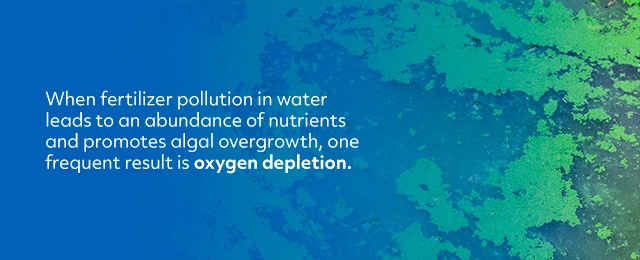
When oxygen levels in an aquatic environment drop, the consequences can be severe. Fish and other organisms may grow sick and die. If you notice a lake covered with blue-green algae and containing unusual numbers of dead fish, a toxic algal bloom is most likely the culprit.
Hypoxia can sometimes create dead zones in bodies of water. One famous example is the dead zone in the northern Gulf of Mexico, which occurs every summer because of excessive nutrient pollution, algal growth, and oxygen depletion. At its largest, in 2017, it measured
8,776 square miles. This dead zone becomes uninhabitable for the many animals that once thrived there — fish, shrimp, and crabs can sometimes swim out of the area, but other organisms slowly suffocate.
5. Biodiversity Loss
As time goes by, an algal bloom in a lake or stream begins to choke out other species. Lowered oxygen levels mean that fish, aquatic plants, and small animals can no longer live there. The altered balance of species has significant impacts on the food chain and larger ecosystem as well. A shortage of fish may drive away mid-chain consumers like otters or herons and lead even apex predators like ospreys and eagles to leave in search of a more reliable food supply.
6. Ocean Acidification
Scientists have known for a while that climate change is making the world's oceans more acidic. The reaction between carbon dioxide and water in our oceans can lead to the formation of carbonic acid. Ocean acidification causes many problems, including interfering with the shell-building abilities of crabs and other organisms that require calcium carbonate to build.
Recent evidence has shown that the eutrophication associated with fertilizer runoff alsoleads directly to coastal ocean acidificationand compounds its harmful effects.
7. Nitrate Poisoning
If fertilizer nutrients like nitrates make it into the drinking water supply, they can have particularly severe adverse health impacts on infants. It's not uncommon for nitrates to contaminate local drinking water. Public water supplies usually receive thorough treatment under federal law, but even so, municipal filters may be older and insufficient for filtering nonbacterial contaminants like nitrates. Babies may be at risk if family members unknowingly use contaminated water to mix their formula.
In infants, especially, nitrates can cause an illness called methemoglobinemia, known colloquially asbluebaby syndrome.Methemoglobinemia occurs when nitrates turn to nitrites in the body and oxidize the iron in our blood's hemoglobin. They cause some of the hemoglobin to turn into an alternate form known as methemoglobin.
Methemoglobinemia can lead to the following:
- Headaches
- Fatigue
- Dizziness
- Confusion
- Seizures
- Coma
- Death
Methemoglobin differs from hemoglobin in that it cannot bind oxygen, so people who develop this illness often see precipitous drops in their blood oxygen saturation. Many infants begin to turn blue because of the lack of oxygen in their bodies. Methemoglobinemia can also cause symptoms such as headaches, fatigue, dizziness, confusion, seizures, coma, and even death.
How to Prevent Fertilizer Runoff
At this point, you may be wondering how to prevent fertilizer runoff from your lawn or garden. Fortunately, you can take steps to reduce runoff and minimize your yard and garden's environmental impact.
To reduce the effects of fertilizer runoff, try applying some of these tips:
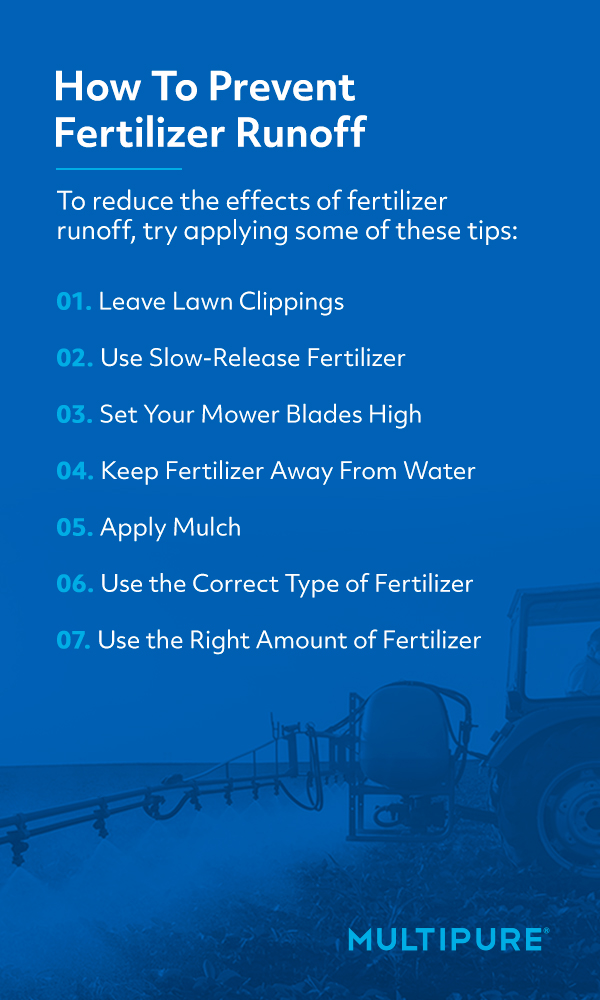
1. Leave Lawn Clippings
When you mow your lawn, consider leaving the lawn clippings there as nourishment. As they decay, they return nutrients to the soil, so they can help you cut down on your need for purchased fertilizer. They also help absorb water to prevent runoff. You can take the collection box off your lawnmower to keep the clippings on your lawn, or you can use a mulching mower to spread the clippings.
2. Use Slow-Release Fertilizer
Rather than unloading large amounts of chemicals into your plants at once, slow-release fertilizer controls its nutrient release, keeping it low and constant during the growing season. This schedule means the fertilizer will release nutrients when the grass is actively growing and can absorb them to prevent fertilizer runoff.
3. Set Your Mower Blades High
Setting your lawnmower blades to 3 inches or highercan help you reduce runoff in your yard. Taller grass will absorb more water, leading to a much stronger root system that keeps water in place and prevents runoff. A healthy root system can also withstand droughts better, so you don't need to water your lawn as much, further reducing the risk of runoff.
4. Keep Fertilizer Away From Water
When you apply fertilizer to your grounds, be sure to keep it away from water sources. If you have a stream running through your property or your yard overlooks a lake, keep your fertilizer well away from these areas to reduce the risk of nutrient pollution.
5. Apply Mulch
When applying fertilizer in your garden, use mulch to your advantage. Spread a layer of compost and apply fertilizer directly to your plant roots before spreading a 2- to 3-inch layer of mulch on top. The mulch will help hold in soil moisture and keep fertilizer in place even during heavy rainfall.
6. Use the Correct Type of Fertilizer
Because of the harmful effects of eutrophication, some states started banning the use of the mineral phosphorus in fertilizer. Today, many fertilizer companies use phosphorus only in fertilizers intended for short-term use on new lawns and gardens. When you're purchasing fertilizer, be sure to get a type that contains only the nutrients you need for your soil.
7. Use the Right Amount of Fertilizer
A good rule of thumb for fertilizing a lawn or garden is to apply half a pound to a pound of nitrogen for every 1,000 square feet. You can tell how much of each nutrient you're getting by looking at the numbers on the bag.
Fertilizer bags typically contain NPK numbers that look something like 10-5-5, where the numbers are the percentages of nitrogen (N), phosphorus (P), and potassium (K), respectively. A 100-pound bag marked 10-20-10 holds 10 pounds of nitrogen, 20 pounds of phosphorus, and 10 pounds of potassium. To apply 1 pound of nitrogen from a bag like this, you'd use 10 pounds of fertilizer.
How Contaminated Water Makes Its Way to Your Home
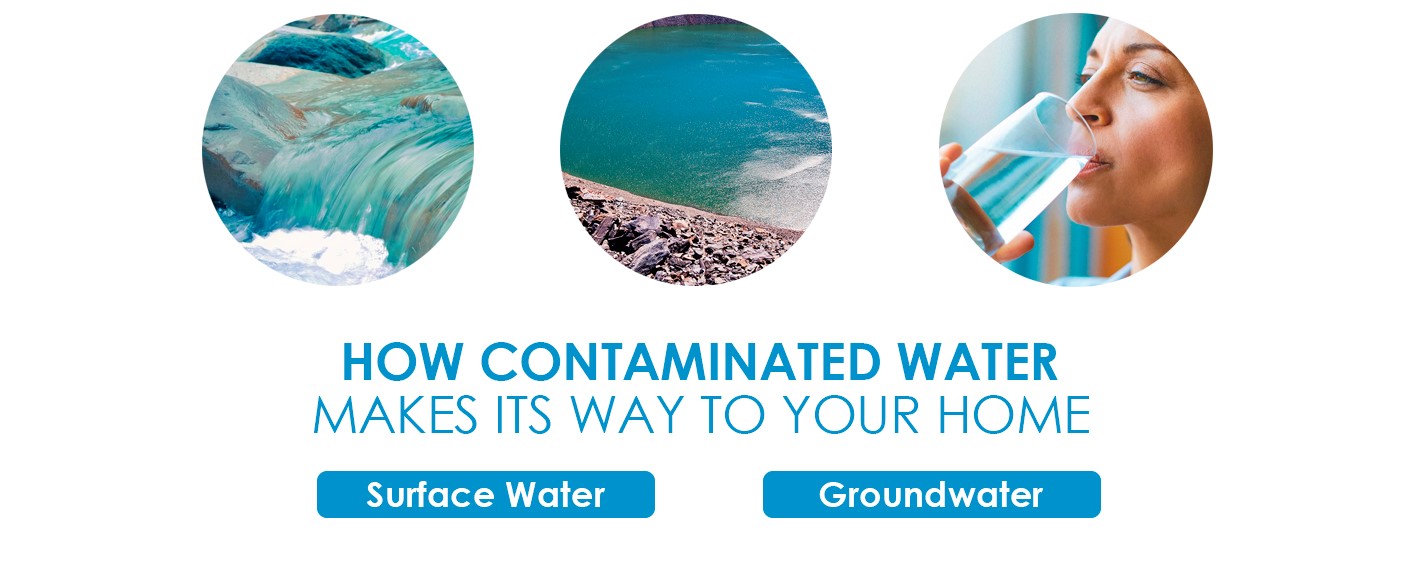
Contaminated water can get into your home in several ways. Agriculture is the primary source of pollution in streams and rivers in the U.S., although wetlands and lakes can also be contaminated. According to the U.S. Environmental Protection Agency (EPA), agriculture is the top cause of impaired water qualityin the U.S. As a primary source of pollution of water, agriculture accounts for 70% of worldwide water withdrawalsand plays a significant role in the contamination of water. Agricultural runoff flows into the rivers and lakes where many towns get their water supply.
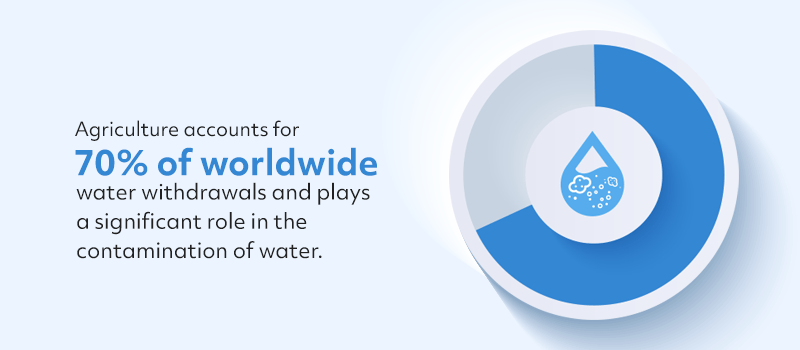
Additionally, water treatment issues, aged or damaged pipes, and other problems can cause contaminated water to enter homes.
Agricultural Runoff
Farms discharge huge quantities of organic matter, agrochemicals, sediments, saline drainage, and drug residues into water bodies. In between frequent storms, ranchers and farmers have brief dry weather stretches that are just long enough for them to apply fertilizers and pesticides. And, each time it rains, animal waste from livestock operations and farms, fertilizers, and pesticides wash pathogens like viruses, bacteria, and nutrients into our waterways.
Uneaten feeds and fish excreta from fed aquaculture diminish the quality of water. An increase in production combined with greater use of fungicides, antibiotics, and anti-fouling agents contributes to the pollution of downstream ecosystems.
Agriculture affects water quality through surface water and groundwater.
1. Surface Water
Surface watercovers around 70% of the earthand fills our lakes, oceans, rivers, and other bodies of water. Almost half of our streams and rivers and over a third of our lakes are polluted, making them unfit for fishing, swimming, and drinking. Nutrient pollution, including phosphates and nitrates, is the main type of contamination in these sources of freshwater. Although animals and plants require these nutrients to grow, they've become a considerable pollutant due to fertilizer and farm waste runoff.
2. Groundwater
When rain falls and seeps into the ground, filling the crevices, cracks, and porous areas of underground aquifers, it becomes groundwater. Approximately half of the U.S. population relies on groundwater, with 145 million Americans getting their tap water for drinking from a groundwater source. Groundwater is the only source of freshwater for some people in rural areas. Pesticides, waste, and fertilizers impact well water and groundwater by leaching into septic systems and landfills, reaching an aquifer, and rendering it unsafe for humans to use. Groundwater may also spread these contaminants far from the initial pollution source as it seeps into lakes, oceans, and streams.
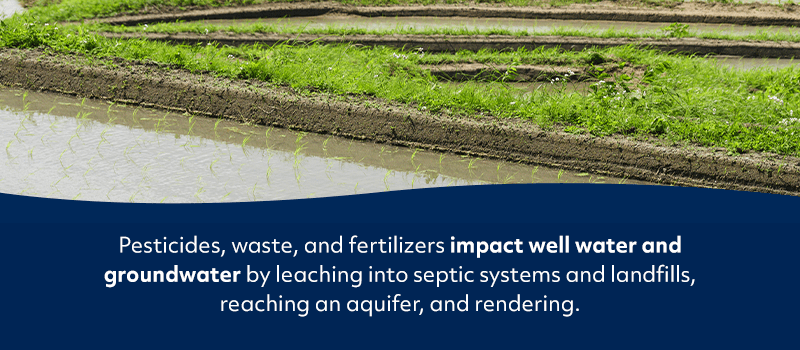
Water Treatment Issues
Sometimes, inadequately treated water can still contain contaminants. While water treatment plants might aim to remove pollutants, outdated infrastructure and other issues in the treatment process could contaminate water reaching homes.
It's also possible for local pollution events such as chemical spills or runoff from hazardous waste sites to contaminate water, especially if the events occur close to water sources or treatment facilities.
Old or Damaged Pipelines
As water travels through damaged or aged pipelines, it can collect contaminants like lead, bacteria, and other pollutants. Corroded pipes or breaks in the distribution system can introduce contaminants into the water before it reaches your home. Additionally, cross-connections between water lines and sewage can also contaminate drinking water if there's a faulty plumbing issue.
Water Storage Issues
If water storage tanks or reservoirs aren't properly maintained, they can become breeding grounds for contaminants like bacteria. These contaminants can enter the distribution system and reach homes.
The Link Between Water Contamination and Your Body
Contaminated water affects your body in several ways. Here are some of the contaminants and their effects:
1. Disease From Sedimentation
Higher levels of turbidity, or cloudiness, are frequently linked with higher levels of microorganisms causing diseases like parasites, viruses, and some bacteria. These microorganisms can cause symptoms in humans such as:
- Cramps
- Headaches
- Diarrhea
- Nausea
2. Illness From Algal Blooms
An abundance of nitrogen and phosphorous in water can cause algae to grow at a faster rate — much faster than ecosystems can properly handle. Significant algae increases can harm habitats and food resources, water quality, and reduce the oxygen aquatic life needs to survive.
Some algal blooms can harm humans since they produce bacterial growth and elevated toxins that can make you sick if you consume tainted shellfish or fish, come into contact with polluted water, or drink contaminated water.
Nutrient pollutants in groundwater can be harmful to the millions of individuals in the U.S. who use groundwater as their drinking water source. Infants are especially susceptible to nitrates in drinking water. Excess nitrogen in our atmosphere can create pollutants like ozone and ammonia, which can limit visibility, impair our ability to breathe, and alter plant growth.
3. Adverse Health Effects From Pesticides
The type of pesticide, route, and duration of exposure and health status of the individual determines the potential health outcome. In the human body, as well as in animals, pesticides can be metabolized, stored, excreted, or bioaccumulated in body fat. Chemical pesticides have been linked with numerous negative health effects that are:
- Gastrointestinal
- Dermatological
- Respiratory
- Carcinogenic
- Reproductive
- Neurological
- Endocrine
4. Disease From Wastewater Exposure
In the agricultural sector, wastewater is increasingly being used to cope with freshwater source depletion as well as water stress associated with changing climate conditions. Exposure to wastewater has been linked to diseases such as:
- Bacterial
- Viral
- Shigellosis
- Salmonellosis
- Hepatitis A
- Cholera
- Protozoan
- Amoebiasis
- Giardiasis
- Other diarrheal diseases
5. Illness From Animal Feeding Operations
Public health concerns linked with concentrated animal feeding operations include an increase in the risk of pathogens passed from animals to humans, food-borne disease, the emergence of antimicrobial and antibiotic-resistant microbes largely due to widespread antimicrobial use for nontherapeutic reasons, and worker health concerns.
6. Water-Borne Disease From Livestock Grazing
When cattle have uncontrolled access to bodies of water, grazing areas, or intensively managed domestic pastures, they can contaminate them with sediment from damaged streambanks and manure.
Drinking contaminated water can cause illnesses known as "water-borne diseases." Contaminants often found in the urine and feces of animals can be bacteria like:
- Campylobacter
- Salmonella
- Parasites like cryptosporidium and giardia
- Viruses
- E. coli
- Toxoplasma
Water contaminated with feces and urine from infected domestic animals is what usually causes water-borne diseases.
How Homes Contribute to Nutrient Pollution
People's homes contribute to nutrient pollution through yards, appliances, pets, and driveways. Roadside storm drains frequently lead directly to local rivers and streams, therefore, anything flowing into them can make their way to local waterways. Residential areas can be a source of phosphorus and nitrogen fertilizer pollution.
These all put you at risk in many ways:
- Over-watering and over-fertilizing lawns: This is common among landscaping services and homeowners. When a garden or yard is over-watered, fertilizer can wash away more easily.
- Pet waste: Pet waste contributes to phosphorus, nitrogen, bacteria, and parasites in water bodies when it's not properly disposed of. It can also lead to unsafe conditions in local bodies of water for human recreation.
- Laundry, car, and dishwashing soaps: Many laundry, car and dishwashing soaps contain phosphates — a form of phosphorus — which are carried from households through drains into the water system.
- Electricity:Using electricity in our homes also adds excess nitrogen to our atmosphere. Many electricity sources come from burning fossil fuels, which cause environmental pollutants.
How to Protect You and Your Family

To understand the steps to take to protect yourself and your family, first evaluate your situation. For instance:
- Do you live near a factory or industrial site?
- Do you use water from a well?
- Do you have pets?
- Do your neighbors use pesticides and fertilizers on their yards?
Here's how to reduce your contributions to contaminated drinking water:
- Choose phosphate-free soaps, detergents, and household cleaners.
- Pick up your pet's waste.
- Reduce your use of pesticides, fertilizers, and herbicides.
- Inspect your septic system yearly.
- Only run your dishwasher or washing machine when there's a full load.
- Pump your septic system out regularly.
- Avoid walking your pet near waterways like streams or rivers. Instead, walk them in parks, grassy areas, or undeveloped areas.
- Use commercial car washes since they're required to dispose of wastewater properly and many of them filter and recycle their water.
- Repair leaking toilets, faucets, and pumps.
- Talk to local legislators about contaminated drinking water.
- Support your local surface water or local storm program.
- Carpool with coworkers or friends.
- Unplug electronics when not in use.
- Filter your own water.
Contact Multipure for Fresh, Clean Drinking Water
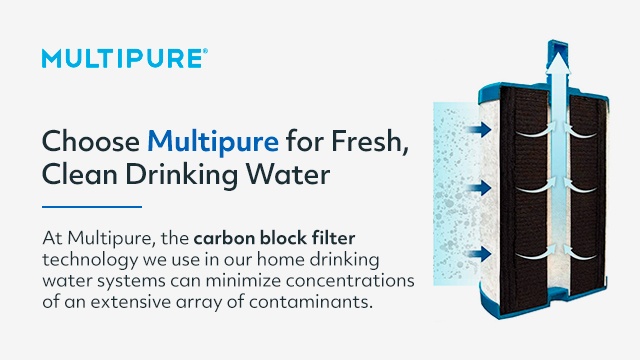
Nitrates and phosphates can affect the quality of your drinking water, and so can a host of other common pollutants. At Multipure, the
carbon block filter technology we use in our home drinking water systems can minimize concentrations of an extensive array of contaminants, including asbestos, chlorine, lead, mercury, and volatile organic compounds (VOCs), among many others. Reducing these contaminant levels can make your water cleaner, fresher, and safer to drink, and the great taste will make you want to stay hydrated all day long.
We also offer lifetime warranties, a 90-day money-back guarantee, and filters proudly made in the United States.
Contact us today to learn more.

